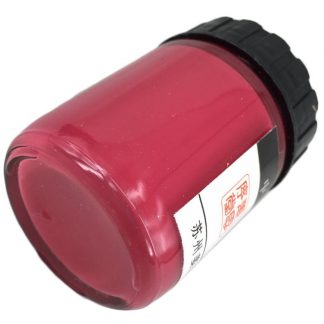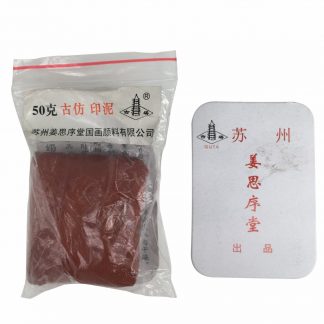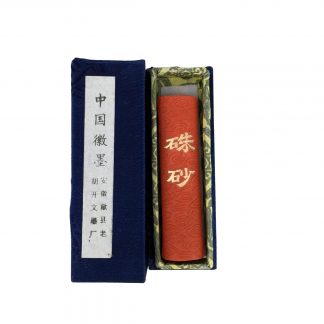Cinnabar
Cinnabar or Vermillion is the naturally occurring mineral mercury sulphide (HgS). Inorganic mercury such as the mercury found in cinnabar is the least toxic form of mercury and has a long history in traditional Chinese medicine, ancient Roman makeup, Hindu Bindi forehead marking and Sindoor hair marking but should still be considered toxic and handled with care, especially in powder form. The US Center for Disease Control and Prevention states:
Inorganic Mercury: When eaten in large amounts, some inorganic mercury compounds can be very irritating and corrosive to the digestive system. If repeatedly eaten or applied to the skin over long period of time, some inorganic mercury compounds can cause effects similar to what is seen with long term mercury vapor exposure, including neurological disturbances, memory problems, skin rash, and kidney abnormalities.
There’s an informative article with references on owlcation.com stating:
There is uncertainty about how poisonous cinnabar is and about the amount required to produce dangerous effects. Scientists generally recommend that we limit our exposure to all mercury compounds, however, including inorganic mercury.
People using cinnabar are warned not to inhale cinnabar dust and to be very careful when breaking the mineral in case dust is created. The mineral mustn’t be ingested or licked. In addition, it mustn’t be heated, which might trigger mercury vapor release. Opinions are divided about whether cinnabar is safe to touch. Mercury (ll) sulfide can be absorbed through the skin, but how much is actually absorbed from a lump of cinnabar mineral is unknown. Since there are unanswered questions about the mineral’s safety, it’s best to wear gloves when handling it.
GHS Statements
GHS07-1: Exclamation Mark
Signal word: Warning
Hazard designation
- EUH031: Contact with acids liberates toxic gas.
- H317: May cause an allergic skin reaction.
Safety Information
- P261: Avoid breathing dust/ fume/ gas/ mist/ vapors/ spray.
- P280: Wear protective gloves/ clothing/ eye/ face protection.
- P302+P352: IF ON SKIN:Wash with plenty of water
- P333+P313: If skin irritation or rash occurs: Get medical attention.
Showing 1–12 of 16 results
-
Cinnabar Red Colour 15g/ 0.54oz
 How to use: use wet brush to apply colour directly on the colour cake. Feature: The chips include resin already. The colour is very fine and pure. Colour is profound and endurable. It is very easy to get colour. Storage: keep it in dry, clean shade. The longer the colour is preserved, the better the quality becomes. Special Note: industrial colour, easy…$23.66 (USD)
How to use: use wet brush to apply colour directly on the colour cake. Feature: The chips include resin already. The colour is very fine and pure. Colour is profound and endurable. It is very easy to get colour. Storage: keep it in dry, clean shade. The longer the colour is preserved, the better the quality becomes. Special Note: industrial colour, easy…$23.66 (USD)
Brand: Jiang SiXu Tang 姜思序堂
Colour: Cinnabar Red 朱膘
Materials: Cinnabar, mineral pigment
Packaging: Ceramic Pot
Recommend to: Advanced Level, Beginners, Medium Level, Professionals
Suitable for: Chinese Painting, 工笔画 Gongbi Painting
Product Weight: 15
Shipping size: 5 × 2 × 2 cm


Cinnabar Red Colour 15g/ 0.54oz
$23.66 (USD) Add -
Jiang SiXu Tang Chinese Paints 30 ml Cinnabar Red 朱膘



Brand: Jiang SiXu Tang 姜思序堂
Materials: Cinnabar
Packaging: glass bottle
Recommend to: Advanced Level, Beginners, Medium Level
Suitable for: Chinese Painting
Product Size: 30 ml paints per glass bottle., 5.5 * 3.5 * 3.5 cm
Product Weight: 114g
Shipping size: 3.5 × 3.5 × 5.5 cm


Jiang SiXu Tang Chinese Paints 30 ml Cinnabar Red 朱膘
$6.35 (USD) Add -
Jiang SiXu Tang Chinese Paints 30 ml Cinnabar 朱砂



Brand: Jiang SiXu Tang 姜思序堂
Materials: Cinnabar, industrial pigment, mineral pigment
Packaging: glass bottle
Recommend to: Advanced Level, Beginners, Medium Level
Suitable for: Chinese Painting
Product Size: 30 ml paints per glass bottle., 5.5 * 3.5 * 3.5 cm
Product Weight: 114g
Shipping size: 3.5 × 3.5 × 5.5 cm


Jiang SiXu Tang Chinese Paints 30 ml Cinnabar 朱砂
$6.35 (USD) Add -
仿古印泥 Aging Appearance Cinnabar Seal Paste



Brand: Jiang SiXu Tang 姜思序堂
Materials: Cinnabar
Recommend to: Advanced Level, Beginners, Medium Level, Professionals
Suitable for: Chinese Seals
Size: refill 30g
Product Weight: 30


仿古印泥 Aging Appearance Cinnabar Seal Paste
$20.50 (USD) Add -
作品用朱砂印泥 Top Grade Professional Cinnabar Seal Paste 50g



Brand: Jiang SiXu Tang 姜思序堂
Grade: Top Grade
Materials: Cinnabar
Packaging: Ceramic Pot, Silk-Lined Cardboard Box, spatula
Recommend to: Advanced Level, Professionals
Suitable for: Chinese Seals
Product Weight: 30
Shipping size: 9 × 9 × 5.5 cm


作品用朱砂印泥 Top Grade Professional Cinnabar Seal Paste 50g
$75.50 (USD) Add -
作品用朱膘印泥 Top Grade Professional Cinnabar Red Seal Paste 50g



Brand: Jiang SiXu Tang 姜思序堂
Grade: Top Grade
Materials: Artemisia Argyi Fibre, Castor Oil, Cinnabar, Confidential Recipe
Packaging: Ceramic Pot, Wooden Box
Recommend to: Advanced Level, Professionals
Suitable for: Chinese Seals
Product Weight: 30
Shipping size: 9 × 9 × 5.5 cm


作品用朱膘印泥 Top Grade Professional Cinnabar Red Seal Paste 50g
$75.50 (USD) Add -
八宝印泥 Eight Treasures Cinnabar Seal Paste



Brand: Jiang SiXu Tang 姜思序堂
Materials: Cinnabar
Recommend to: Advanced Level, Beginners, Medium Level, Professionals
Suitable for: Chinese Seals
Size: L, M, refill, S


八宝印泥 Eight Treasures Cinnabar Seal Paste
$26.60 – $37.09 Choose -
古方印泥 Ancient Recipe Cinnabar Seal Paste



Brand: Jiang SiXu Tang 姜思序堂
Materials: Cinnabar
Recommend to: Advanced Level, Beginners, Medium Level, Professionals
Suitable for: Chinese Seals
Size: refill 30g
Product Weight: 30


古方印泥 Ancient Recipe Cinnabar Seal Paste
$20.50 (USD) Add -
堆朱印泥 Dui Zhu Cinnabar Seal Paste



Brand: Jiang SiXu Tang 姜思序堂
Materials: Cinnabar
Recommend to: Advanced Level, Beginners, Medium Level, Professionals
Suitable for: Chinese Seals
Size: L, M, refill, S


堆朱印泥 Dui Zhu Cinnabar Seal Paste
$22.69 – $26.03 Choose -
朱砂印泥 Cinnabar Seal Paste



Brand: Jiang SiXu Tang 姜思序堂
Materials: Cinnabar
Recommend to: Advanced Level, Beginners, Medium Level, Professionals
Suitable for: Chinese Seals
Size: L, M, refill, S


朱砂印泥 Cinnabar Seal Paste
$26.60 – $31.34 Choose
Showing 1–12 of 16 results



